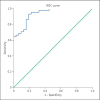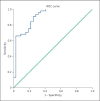Peripheral Immune Cell Counts and Advanced Imaging as Biomarkers of Stroke Outcome
- PMID: 27771707
- PMCID: PMC5122990
- DOI: 10.1159/000450620
Peripheral Immune Cell Counts and Advanced Imaging as Biomarkers of Stroke Outcome
Abstract
Introduction: Circulating neutrophil and lymphocyte levels may be modifiable outcome predictors of ischemic stroke. We sought to compare these immune cell parameters with advanced imaging assessment and the 90-day clinical outcome.
Methods: We used a retrospectively collected cohort of consecutive ischemic stroke patients presenting within 4.5 h of symptom onset who had acute CT perfusion and routine blood collection before treatment with intravenous thrombolysis and 24-hour MRI scanning at the John Hunter Hospital. Full blood counts were performed acutely at 24 h and 7 days. Patient outcomes were assed at 90 days after stroke with the modified Rankin Scale (mRS).
Results: Overall, 142 patients were assessed during the study period. Patients with a poor outcome (mRS 3-6) had increased neutrophils (44% increase, p = 0.016), decreased lymphocytes (7% decrease, p = 0.491) and an increased lymphocyte-to-neutrophil ratio (196% increase, p < 0.001). Patients with good outcomes (mRS 0-2) did not have significant changes in their full blood counts. There was no relationship between the neutrophil count at 24 h and penumbral volume (r2 = 0.217, p = 0.212), reperfusion (r2 = 0.111, p = 0.085), or core growth (r2 = 0.297, p = 0.107). A backward multivariate analysis containing the 24-hour core volume and 24-hour neutrophil count was strongly related to the 3-month outcome (r2 = 0.477, area under the curve = 0.902, p < 0.001).
Conclusions: Peripheral neutrophils have potential as a biomarker of outcome when used in conjunction with advanced imaging. Peripherally measured neutrophil counts change significantly over time after stroke and may be potential targets for immunomodulatory therapy in patients with a severe stroke or a large infarct volume.
Keywords: Cell count; Ischemic stroke; Lymphocytes; Neutrophils.
© 2016 The Author(s) Published by S. Karger AG, Basel.
Figures


Similar articles
-
Trial design and reporting standards for intra-arterial cerebral thrombolysis for acute ischemic stroke.Stroke. 2003 Aug;34(8):e109-37. doi: 10.1161/01.STR.0000082721.62796.09. Epub 2003 Jul 17. Stroke. 2003. PMID: 12869717
-
Early infarct growth predicts long-term clinical outcome in ischemic stroke.J Neurol Sci. 2014 Dec 15;347(1-2):205-9. doi: 10.1016/j.jns.2014.09.048. Epub 2014 Oct 2. J Neurol Sci. 2014. PMID: 25304056
-
Infarct growth despite full reperfusion in endovascular therapy for acute ischemic stroke.J Neurointerv Surg. 2016 Feb;8(2):117-21. doi: 10.1136/neurintsurg-2014-011497. Epub 2014 Dec 24. J Neurointerv Surg. 2016. PMID: 25540178
-
Large Volumes of Critically Hypoperfused Penumbral Tissue Do Not Preclude Good Outcomes After Complete Endovascular Reperfusion: Redefining Malignant Profile.Stroke. 2016 Jan;47(1):94-8. doi: 10.1161/STROKEAHA.115.011360. Epub 2015 Nov 24. Stroke. 2016. PMID: 26604248
-
The growth rate of early DWI lesions is highly variable and associated with penumbral salvage and clinical outcomes following endovascular reperfusion.Int J Stroke. 2015 Jul;10(5):723-9. doi: 10.1111/ijs.12436. Epub 2015 Jan 12. Int J Stroke. 2015. PMID: 25580662 Free PMC article.
Cited by
-
MicroRNA-99a-5p in circulating immune cells as a potential biomarker for the early diagnosis of ischemic stroke.Brain Circ. 2017 Jan-Mar;3(1):21-28. doi: 10.4103/bc.bc_1_17. Epub 2017 Mar 29. Brain Circ. 2017. PMID: 30276300 Free PMC article.
-
The significance of eosinophils in predicting the severity of acute ischemic stroke.Oncotarget. 2017 Oct 31;8(61):104238-104246. doi: 10.18632/oncotarget.22199. eCollection 2017 Nov 28. Oncotarget. 2017. PMID: 29262636 Free PMC article.
-
Prognostic role of dynamic neutrophil-to-lymphocyte ratio in acute ischemic stroke after reperfusion therapy: A meta-analysis.Front Neurol. 2023 Feb 16;14:1118563. doi: 10.3389/fneur.2023.1118563. eCollection 2023. Front Neurol. 2023. PMID: 36873451 Free PMC article.
-
Prognostic value of the neutrophil-to-lymphocyte ratio in acute ischemic stroke patients treated with intravenous thrombolysis: a systematic review and meta-analysis.BMC Neurol. 2021 May 11;21(1):191. doi: 10.1186/s12883-021-02222-8. BMC Neurol. 2021. PMID: 33975565 Free PMC article.
-
[Construction and evaluation of a model for predicting ischemic stroke risk in patients with sudden sensorineural hearing loss].Lin Chuang Er Bi Yan Hou Tou Jing Wai Ke Za Zhi. 2021 Dec;35(12):1078-1084. doi: 10.13201/j.issn.2096-7993.2021.12.005. Lin Chuang Er Bi Yan Hou Tou Jing Wai Ke Za Zhi. 2021. PMID: 34886620 Free PMC article. Chinese.
References
-
- Macrez R, Ali C, Toutirais O, et al. Stroke and the immune system: from pathophysiology to new therapeutic strategies. Lancet Neurol. 2011;10:471–480. - PubMed
LinkOut - more resources
Full Text Sources
Other Literature Sources

